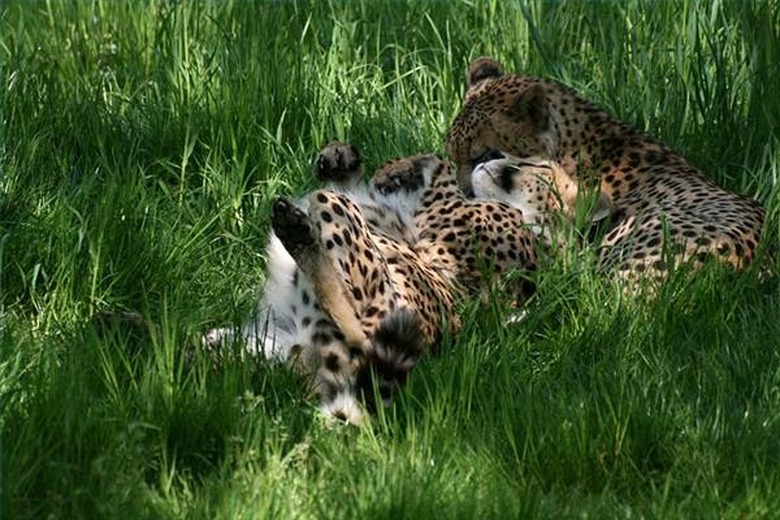How Do Cheetahs Reproduce?
Native to the grasslands, semi-deserts and savannas of Africa, portions of the Middle East and Western and South Asia, cheetahs are perhaps the most unique of the big cats.
That's certainly true when it comes to their body plan and lifestyle: Built like a greyhound where most of their cousins are burly and heavily muscled, cheetahs are the swiftest land mammals in the world, capable of top speeds approaching 70 miles per hour.
The business of making new cheetahs requires males and females, which ordinarily don't cross paths, to come together – and demands a lot of vigilance on the part of the mother cat, whose cubs in many corners of cheetah country face a slew of formidable enemies.
Timing of Cheetah Reproduction
Timing of Cheetah
Reproduction
Cheetahs don't have a set breeding season. Females, which reach sexual maturity at about 1.5 years, may come into heat throughout the year, although in some areas more breeding may take place during or just after the rainy season.
One study in the central plains of the East African Serengeti found more cheetah litters during the wet season, which may be partly tied to a peak then in fawning among Thompson's gazelles, which are among the cheetah's favored prey.
Sexually receptive ("estrus") females will advertise their status with urine-marking, and males will make calls, upon coming across such evidence, that may draw females in. A 2009 study showed that a particular vocalization by male cheetahs – the so-called "stutter bark" – can actually trigger the release of reproductive hormones in females, inducing ovulation.
Cheetah Mating
Cheetah Mating
Once they're sexually mature, female cheetahs are mainly solitary, associating with other cheetahs only during mating and when rearing young.
Male cheetahs either hold territories or live as non-territorial "floaters." Males often form coalitions to better secure territories, an unusual social strategy that may also help them better waylay receptive females. Females travel over large home ranges that usually overlap with multiple male territories, and they often mate with several males, both territorial ones and floaters. This kind of promiscuity can result in increased genetic diversity within a cheetah litter, which may boost cub survival.
Cheetah sex between a given male and female often plays out over a few days, and male coalitions in particular often do their best to monopolize females as long as they can.
Rearing Cubs
Rearing Cubs
Female cheetahs give birth about 90 to 95 days after conception.
They seek out dense cover, such as shrub thickets or dense stands of tall grass, for their lairs. Litters include an average of three or four cubs, born blind. Cheetah cubs have a characteristic silvery ruff on their back that may have evolved to give them the look of the ratel, or honey badger.
Because many carnivores avoid tangling with that feisty and ferocious member of the weasel family, mimicking the ratel's look may be an antipredator advantage for a comparatively defenseless cheetah kit, though this widely held theory can't be definitively proven.
Cheetah cubs spend their first couple of months mostly hiding in their lair, though at five or six weeks old or so they're able to follow their mother to new hiding places.
As they're weaned off her milk, she'll lead them directly to her kills. Mothers teach cubs the ropes of killing prey by bringing them live hares, gazelle fawns and other small creatures to practice on. Cubs also spend much of their time playing with one another, and games of chase help them hone their skills at tripping and tackling quarry.
A Perilous World for Cheetah Cubs
A Perilous World for Cheetah Cubs
Cheetah litters can suffer high mortality. Cubs may die of exposure or abandonment, and they're vulnerable to a host of potential predators. In Africa, the most significant are lions and spotted hyenas. Many studies show significantly higher cub survival in areas with lower densities of lions and spotted hyenas.
Lions that notice a female cheetah often rush over and actively search for her lair, and they'll kill any cub they come across.
In the face of much more powerful hyenas and lions, there's not much a mother cheetah can do to actively defend her offspring, which have the best chance of survival by staying out of sight; the mother cheetah also practices concealment strategies, such as remaining low in cover when nursing and visiting cubs after nightfall.
Saying Farewell to Mom
Saying Farewell to Mom
Once they're fully weaned and mobile, cheetah cubs travel about with their mother. Once they're about a year and a half old, they separate from the mother, who may at that point be pregnant again. The independent cubs often continue associating with one another for several more weeks or months before going it alone, though brothers may stay together as the foundation of a coalition.
Females tend to establish home ranges in the vicinity, while males strike off for territories farther afield.
Cite This Article
MLA
Shaw, Ethan. "How Do Cheetahs Reproduce?" sciencing.com, https://www.sciencing.com/cheetahs-reproduce-4566385/. 22 November 2019.
APA
Shaw, Ethan. (2019, November 22). How Do Cheetahs Reproduce?. sciencing.com. Retrieved from https://www.sciencing.com/cheetahs-reproduce-4566385/
Chicago
Shaw, Ethan. How Do Cheetahs Reproduce? last modified March 24, 2022. https://www.sciencing.com/cheetahs-reproduce-4566385/
